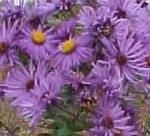 New England aster, also called Michaelmas daisy, is a herbaceous perennial native to much of the US from the Rocky Mountains to the East Coast where it grows in a variety of habitats including moist open woodlands, prairies, along streams, and in disturbed areas. It is a member of the Asteracae family that also includes daisies, sunflowers, and lettuce. The plants have somewhat woody stems, are hairy above, branching, and covered with gray green foliage. The leaves are lanceolate to oblong, four to five inches long, and clasp the stem. They have entire margins and are rough-hairy above and soft hair below. In late summer through early fall the plant is covered with loose leafy corymbs of flowerheads 1.5 to 2 inches across. Each flowerhead consists of about forty to fifty ray flowers surrounding a center of yellow disc flowers. The flowers attract bees and butterflies including monarchs, and the foliage is the larval host for butterflies including Pearl Crescent (Phyciodes tharos) and checkerspot. A good choice for back of the border and for butterfly, wildflower or native gardens. Flowers are good in the vase. Many outstanding cultivars are available that vary in flower color and size. The generic name Aster comes from the Latin word aster meaning star and refers to the shape of the flower. The generic name Symphyotrichum comes from the Greek symph meaning coming together and trich meaning hair and possible refers to the anthers. The specific epithet novae-angliae comes from the Latin words novus meaning new and anglia meaning England referring to the plants’ geographical distribution.
New England aster, also called Michaelmas daisy, is a herbaceous perennial native to much of the US from the Rocky Mountains to the East Coast where it grows in a variety of habitats including moist open woodlands, prairies, along streams, and in disturbed areas. It is a member of the Asteracae family that also includes daisies, sunflowers, and lettuce. The plants have somewhat woody stems, are hairy above, branching, and covered with gray green foliage. The leaves are lanceolate to oblong, four to five inches long, and clasp the stem. They have entire margins and are rough-hairy above and soft hair below. In late summer through early fall the plant is covered with loose leafy corymbs of flowerheads 1.5 to 2 inches across. Each flowerhead consists of about forty to fifty ray flowers surrounding a center of yellow disc flowers. The flowers attract bees and butterflies including monarchs, and the foliage is the larval host for butterflies including Pearl Crescent (Phyciodes tharos) and checkerspot. A good choice for back of the border and for butterfly, wildflower or native gardens. Flowers are good in the vase. Many outstanding cultivars are available that vary in flower color and size. The generic name Aster comes from the Latin word aster meaning star and refers to the shape of the flower. The generic name Symphyotrichum comes from the Greek symph meaning coming together and trich meaning hair and possible refers to the anthers. The specific epithet novae-angliae comes from the Latin words novus meaning new and anglia meaning England referring to the plants’ geographical distribution.
Type: Herbaceous perennial
Bloom: Loose leafy corymbs of flowerheads 1.5 to 2 inches across each consisting of about forty to fifty ray flowers surrounding a center of yellow disc flowers in late summer to early fall
Size: 4-6’ H x 4’ W
Light: Full sun; tolerates shade but may need staking
Soil: Average, medium moist, well-drained
Hardiness: Zones 4-8
Care: Pinch made before mid summer to encourage bushiness and reduce ultimate size; divide every two to three years.
Pests and Diseases: Powdery mildew, aster wilt
Propagation: Division in spring or fall; Stem cuttings in spring or early summer
Companion Plants: Switch grass (Panicum spp.) especially ‘Heavy Metal’, Arkansas amsonia (for its yellow foliage), goldenrod , Henry’s Garnet Sweetspire, Sedum ‘Autumn Joy’
Outstanding Selections:
‘Alma Potschke’ (3-4’ H, bright rose flowerheads 1-2” across)
‘Harrington Pink (3-5’ H, salmon pink; late bloomer)
‘Mt. Everest’ (3’ H, white flowers)
‘Purple Dome’ (18-14″ H, purple flowers, compact plant that never needs staking)
‘September Ruby’ (3-5’H, ruby red flowers)
‘Hella Lacy’ 3 to 4 foot H, dark purple flowers)